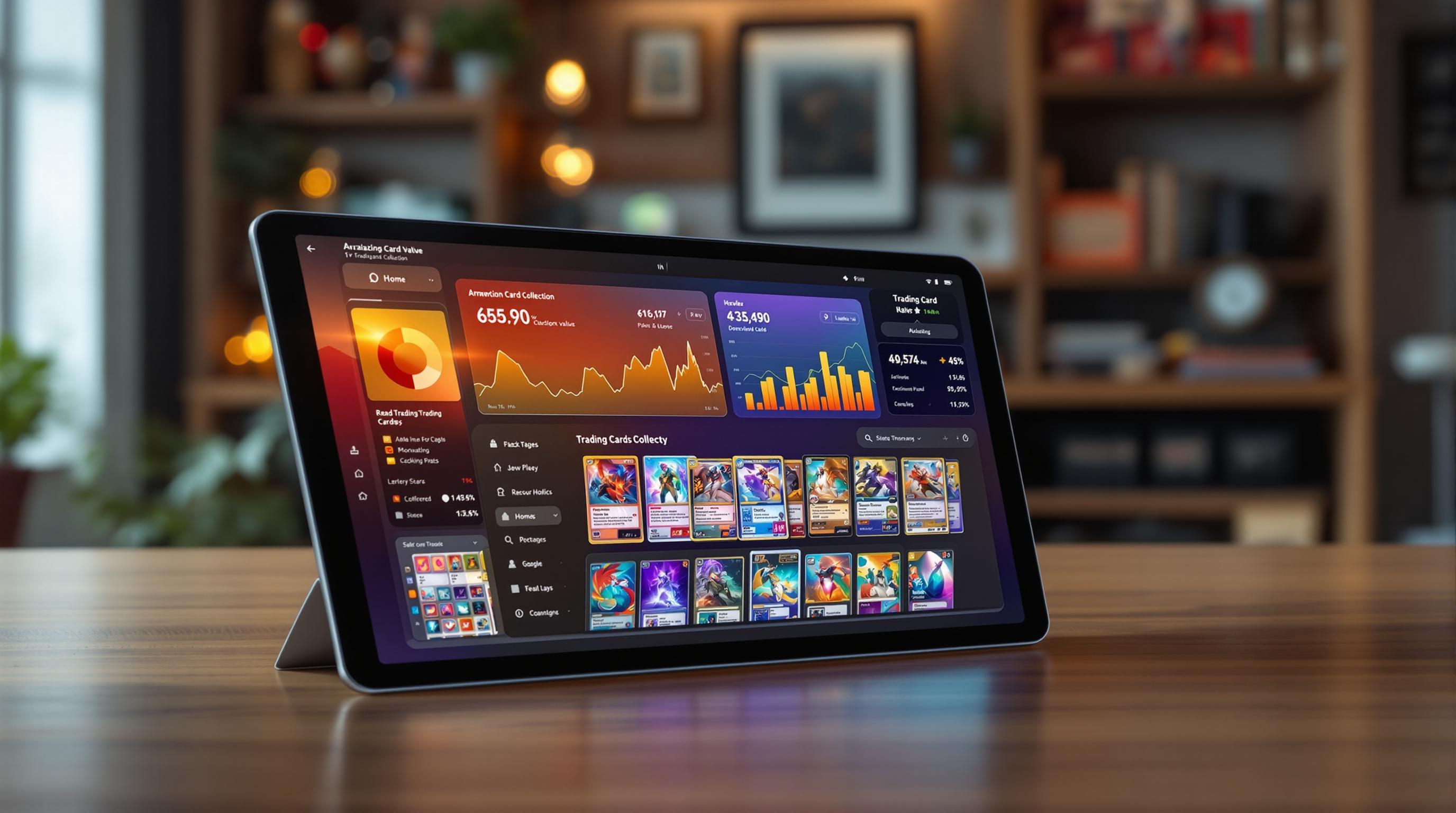Want to level up your trading card collection in 2025? Here's what you need to know:
- Diversify Your Collection: Balance vintage, modern, and digital cards for a well-rounded portfolio.
- Master Card Grading: Learn PSA/BGS standards and use digital tools to boost your skills.
- Find Trusted Resources: Use platforms like Card Shops List to discover local stores and online marketplaces.
- Track Market Trends: Follow pricing data and events to time your buys, sells, and holds effectively.
- Join Events & Communities: Attend conventions and network with collectors to expand knowledge and find rare cards.
- Embrace Digital Collecting: Explore blockchain-backed digital cards for secure, easy-to-trade assets.
- Set Clear Goals & Budget: Use SMART goals and allocate funds wisely to grow your collection.
Quick Tip: Stay informed with tools like Elite Fourum and CardCollector.co.uk to track trends and prices. Whether you're into vintage classics or digital NFTs, these strategies will help you succeed in the evolving card market.
10 Things I Learned My 1st Year In Sports Cards
1. Build a Collection with Vintage, Modern, and Digital Cards
Creating a collection that includes vintage, modern, and digital cards is a smart move for collectors in 2025. Mixing these types of cards not only adds variety but also helps balance potential risks and rewards as the market evolves. With the sports card market expected to grow from $13 billion in 2021 to $49 billion by 2032, having a diverse collection is more important than ever.
Vintage Cards: The Backbone
Vintage cards are the heart of any high-value collection. These cards carry historical significance and often increase in value over time. For example, a 1952 Topps Mickey Mantle card in near-mint condition remains highly sought after and continues to command top-dollar prices, making it a solid investment piece.
Modern Cards: Capturing the Present
Modern cards are a great way to stay connected to the current market. They’re more accessible and can yield impressive returns, especially when focusing on popular players or promising rookies. A PSA 10 graded 2020 Topps Update Mike Trout card is a perfect example of how modern cards can hold strong investment potential.
Digital Cards: Embracing New Trends
Digital cards, offered by platforms like Topps and Panini, bring blockchain-backed authenticity and easy trading options to the table. These cards represent a new era in collecting, combining verified ownership with the convenience of digital transactions.
To get the most out of your collection, allocate your budget carefully. Focus on high-grade cards, use trusted grading services, and stick to reliable platforms for buying and selling. Vintage cards provide long-term value, modern cards offer opportunities for growth, and digital cards open the door to the future of collecting.
2. Improve Your Card Grading Skills
Becoming skilled at card grading is a must for collectors aiming to boost their collection's worth in 2025. Grading not only protects your cards but also helps you stay ahead of market trends. Services like PSA and BGS follow strict standards that significantly influence card values, making grading expertise an important tool for serious hobbyists.
What Grading Means and Why It Matters
Grading involves evaluating aspects like centering, corners, edges, and surface condition - each playing a role in determining a card's value. Third-party grading services add trust and can increase a card's market price, with higher grades often fetching top dollar. This process has become a key part of ensuring your collection's authenticity and value.
Steps to Sharpen Your Skills
- Familiarize yourself with PSA and BGS grading guidelines.
- Practice grading with less valuable cards before moving on to rare ones.
- Use AI-powered tools to get detailed condition reports and spot counterfeits.
- Join workshops to learn directly from industry experts.
- Connect with collector communities for feedback and advice.
Leveraging Technology
Advancements in digital grading platforms have made it easier for collectors to refine their grading abilities. These tools work alongside professional services, offering detailed analyses and helping you make smarter choices about your collection. By blending traditional grading methods with modern technology, these platforms provide more precise evaluations.
Improving your grading skills is just one piece of the puzzle - finding the best shops and platforms to grow your collection is equally important.
3. Use Card Shops List to Find Local and Online Resources

Card Shops List connects collectors with both local stores and online platforms, simplifying the process of building and managing collections.
Find Local Shops
By entering your zip code, Card Shops List helps you discover nearby stores. Visiting local shops comes with several perks:
- Inspect cards in person before buying
- Access grading submission services directly
- Build relationships with knowledgeable dealers
- Trade or purchase cards instantly
Explore Online Marketplaces
The platform also links collectors to trusted online marketplaces like eBay and COMC. These sites offer extensive card selections, competitive prices, and 24/7 availability. Plus, you can tap into features like grading services, real-time price guides, and community forums for trading and discussions.
Focus on Security and Authenticity
Card Shops List emphasizes safe and authentic transactions. It highlights platforms that use blockchain technology to verify trades and protect investments, giving collectors peace of mind.
Specialty Shops for Unique Needs
For collectors with specific interests, specialty shops offer tailored services like sourcing rare cards, expert authentication, and collection evaluations. Many also host card break events, combining social interaction with opportunities to snag valuable cards.
Armed with these resources, collectors can better navigate the market and make smarter choices.
4. Follow Market Trends and Analyze Sales Data
Keeping up with market trends is crucial for collectors looking to decide whether to buy, sell, or hold their cards. The trading card market, valued at over $13 billion in 2021, continues to shift with the rise of both physical and digital card options.
The Role of Digital Platforms
Blockchain technology has made verifying authenticity much easier, opening the door for collectors to explore digital trading cards. You can dive into this space through NFT marketplaces, digital card platforms, and blockchain-backed trading systems.
Tools for Market Analysis
To stay informed, platforms like CardCollector.co.uk and eBay's sales history offer real-time pricing and trend data. For community-driven insights, Elite Fourum is a go-to for discussions on market activity. Once you spot trends, focus on the factors that drive card values.
What Affects Card Value?
- PSA Grades: Cards with high PSA grades continue to command top prices.
- Vintage Cards: Rare examples like the Magneton Pokémon Center Promo and Charizard SIR are expected to grow in value due to their scarcity and collector interest.
- Digital Expansion: While traditional cards hold their appeal, the expanding digital market introduces fresh opportunities and challenges for collectors.
Timing the Market
Card values can spike around special events like Hall of Fame inductions or the release of new series. For instance, Pokémon's Scarlet and Violet Base set has drawn attention as a potential investment. Stay alert to major releases and championship events, as these can trigger immediate shifts in demand.
Tracking Prices
Specialized platforms are invaluable for monitoring price changes across specific sets. Focus on limited editions, promotional cards, and those featuring popular players or characters. These tend to show the most noticeable price movements, making them key targets for investment tracking.
sbb-itb-0db97a5
5. Join Industry Events and Collector Communities
Collecting in 2025 isn’t just about buying and selling. It’s about connecting with others who share your passion. Industry events and collector groups offer fantastic opportunities to grow your collection and knowledge.
Major Industry Events
Events like the National Sports Collectors Convention (NSCC) are must-attend gatherings for serious collectors. At NSCC, you can participate in workshops and learn about authentication. Similarly, the Topps Card Show and Beckett Grading Services (BGS) Card Show provide access to exclusive cards and early previews of new releases.
If attending in person isn’t an option, virtual conventions and online events are now widely available. These let you network and learn without leaving home.
Tips for Making the Most of Events
- Plan Ahead: Research exhibitors, set a spending limit, and bring storage options for your purchases.
- Build Connections: Talk to dealers who specialize in your area of interest. These relationships often lead to rare finds and private offers.
- Learn from Experts: Attend workshops to gain insights into authentication techniques and market trends.
But events are just one part of the puzzle. Staying active in collector communities can take your experience to the next level.
Digital Communities and Forums
Platforms like Elite Fourum are perfect for collectors to exchange ideas, discuss trends, and connect locally. These forums can help you:
- Develop better collection strategies
- Stay updated on market trends
- Gain authentication tips
- Meet other collectors in your area
Why Community Matters
Being part of a collector community has its perks. Members often get early access to private sales and trades, and many uncover their most prized items through these networks rather than traditional marketplaces.
As the trading card market continues to grow, these relationships are becoming even more important. They help collectors stay on top of trends and find opportunities that might otherwise be out of reach.
6. Learn About Digital Collecting and Blockchain Cards
Digital collecting is changing the way people approach trading cards, especially as we move into 2025. Blockchain technology has added new layers of security and transparency, making it easier to verify ownership and authenticity. Collectors who embrace digital cards are staying ahead in this evolving market.
Understanding Digital Cards
Blockchain-based cards exist entirely online, backed by technology that ensures they are genuine and cannot be duplicated. These cards offer benefits like instant verification, easy storage, and protection from physical wear and tear, making them a practical choice for modern collectors.
Security Tips for Digital Collectors
To keep your digital cards safe, follow these guidelines:
- Choose trusted digital wallets.
- Enable two-factor authentication.
- Look into the security features of your chosen platform.
- Store private keys securely.
Popular Platforms and Opportunities
Platforms like NBA Top Shot have demonstrated how blockchain can transform collecting. They’ve opened up new ways for fans to buy, sell, and trade digital assets, giving collectors exciting new possibilities to explore.
Market Growth and Trends
The sports card market is expanding quickly, and digital collectibles are a big part of this growth. Features like easier access, better security, and increasing acceptance in mainstream culture are driving this surge.
Starting Your Digital Collection
For those new to digital collecting, platforms like OpenSea, NBA Top Shot, and Rarible offer reliable starting points. Each platform has its niche, from sports highlights to digital art, so you can find one that matches your interests.
Verifying Authenticity
Blockchain technology guarantees that each digital card is genuine and includes a clear record of ownership. Every card is tied to a unique blockchain token, ensuring both its authenticity and secure transferability.
As digital collecting continues to evolve, having a clear plan and budget will help you navigate both digital and physical collecting spaces with confidence.
7. Set a Budget and Define Collection Goals
Having a clear budget helps you stay on track and avoid overspending, making it easier to work toward your collecting goals. Whether you're into physical cards, digital assets, or both, planning ahead is key to navigating the 2025 trading card market.
Setting Clear Collection Goals
Your goals should follow the SMART framework: Specific, Measurable, Achievable, Relevant, and Time-bound. Instead of saying, "I want a valuable collection", aim for something like: "Complete a PSA 9 or better 2024 Topps Chrome Baseball set by June 2025." This gives you a clear target to work toward.
Building Your Collection Budget
Break your budget into categories to keep things organized. Here's a common approach:
- 60-70% for acquiring cards
- 20-25% for grading services
- 10-15% for storage and protection
Set aside a small amount for unexpected finds or opportunities. Be ready to adjust these percentages if market trends shift.
Track your spending and progress by monitoring:
- How purchase prices compare to current market values
- Grading costs and results
- Expenses for storage and protection
- Overall changes in your collection's value
Using Market Research to Guide Spending
Leverage your market research (covered in Section 4) to make smart buying decisions and boost your returns. Regularly review your budget to spot what's working and what isn't. Tools like automated price alerts for specific cards or a digital spreadsheet can make tracking easier.
Balancing Digital and Physical Collecting
If you're collecting digital assets alongside traditional cards, make sure to include these costs in your budget. Adjust your spending based on your strategy and where you see the best opportunities.
Conclusion
The trading card market is changing quickly, and collectors need to stay on top of these shifts to succeed in 2025. Achieving success means setting clear, actionable goals (think SMART: Specific, Measurable, Achievable, Relevant, and Time-bound) and sticking to solid financial habits.
Creating a balanced collection takes effort and attention to detail. Digital tools and blockchain technology have reshaped how collectors authenticate, trade, and protect their cards. Meanwhile, professional grading services remain crucial for determining card values.
Doing your homework is key. Researching the market and engaging with the collector community can give you a better understanding of trends and help you make smarter choices. Whether through local card shops, online platforms, or networking with other collectors, these connections can make a big difference. Keeping up with changing trends will also help you stay ahead.
Here are some strategies to keep in mind:
- Portfolio Balance: Mix vintage cards, modern releases, and digital assets for a diverse collection.
- Skill Development: Sharpen your grading skills to make better decisions.
- Market Awareness: Keep an eye on trends and price changes.
- Community Engagement: Get involved in events and online forums to expand your network.
- Financial Discipline: Stick to your budget while exploring new opportunities.
The future of trading cards looks promising, with technology and growing interest driving the market forward. By focusing on these strategies and staying flexible as the market evolves, you'll be in a strong position to reach your collecting goals in 2025.
FAQs
How to become a good card collector?
Building a strong card collection starts with a clear plan. Focus on a specific area, like a certain era, team, or player, and follow these tips:
- Research market values on platforms like CardMavin and Beckett Grading Services.
- Understand grading standards by learning from PSA and Beckett.
- Set a budget that works for you and stick to it.
- Store your cards properly to keep them in the best condition.
- Connect with experienced collectors at events to learn from their expertise, spot trends, and find rare cards that might not be widely available.
Specializing in a niche often leads to a more valuable collection. Staying informed about market trends can also give you an edge as the industry evolves.
What is the future of trading cards?
New technology is reshaping the trading card world. Digital platforms and blockchain are opening up opportunities for collectors, offering tools like secure authenticity verification and reducing the risks of counterfeits.
| Trend | Example |
|---|---|
| Digital Collectibles | Exclusive releases on Topps Digital |
| Blockchain Integration | Verified ownership and secure trading |
| Market Growth | Expected to hit $49 billion by 2032 |
"Digital and blockchain-based cards are revolutionizing collecting with secure, transparent trading options", say industry experts monitoring these changes.
Collectors who combine traditional and digital approaches are in a great position to succeed. Platforms like Fanatics and Topps Digital are leading the charge in this evolving space.


